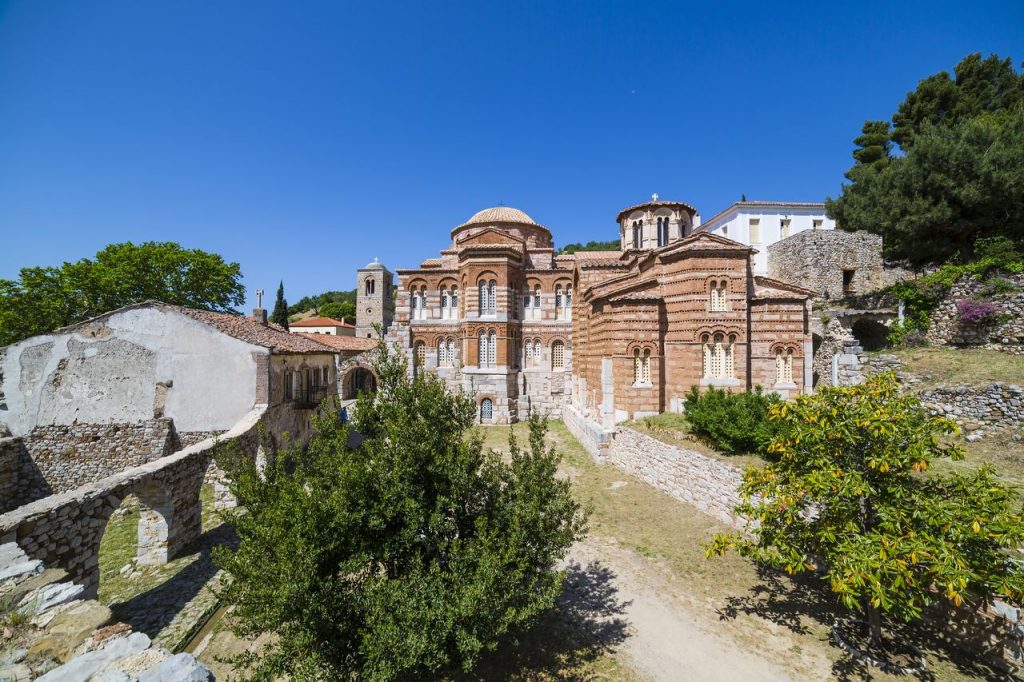Osios Loukas

It is one of the most important Byzantine monuments in Greece. The Monastery of Osios Loukas is located on the slopes of Mount Helicon in Boeotia, surrounded by lush olive grove and it is 35 km from Delphi. It exists from the 11th century. It is dedicated to Osios Loukas, who lived in one of the finest in Byzantium in the 10th century (29 July 896-7 February 953 ), and he has been there during the last years of his life. The information we have about the founding of the monastery from the life of Osios, written by an unknown student shortly after his death.
The community of the monastery includes two large churches, the church dedicated to Osios Loukas and Church of Holy Mary, dedicated to the Assumption. Both estimated that built the first decades of the 11th century and they considered some of the oldest Byzantine monuments in Greece. The Monastery of Osios Loukas has also Crypt, belfry, cells and other auxiliary buildings as the fotanamma the vordonareio (stable) while the old Bank has been turned into a museum.
The Monastery of Osios Loukas is included in the list of UNESCO as a world heritage site and it is considered a model of Byzantine art. Life in the monastery was maintained almost continuously for 1000 years. During the Frankish was inhabited by Latins monks and passed to the Orthodox in the Ottoman period. Meet major disasters in the ancient history but the restoration work that started in 1938 show and highlighted the significance. The monastery celebrates on 7 February, 3 May (Removal of the Holy Relics of Osios Loukas and anniversary of inauguration of the monastery church) Sunday of the Forefathers (Removal the Holy Relic ) and in the fifteenth of August.
Osios Loukas and the vassilomonastiro of Byzantium
Osios Loukas was famous for Christian work already alive. It had the natural gift even according to the testimony and tradition to predict the future and in one of those prophecies, he read the reconquest of Crete by the Saracens, by the Emperor Romanos II: “Romanos will occupate Crete”, said Saint and he stated when he was asked how it was for thelater rather Romanos I, who reigned then. The fame of Byzantium gained immense scope which continued to the monastery after his death. Osios Loukas started building temple in that point, dedicated to Saint Barbara. When he died in 95, his disciples had built in the part of the cell where the buried cross build and they finished the temple, dedicated to the Holy Mary finally: after the verification of prophecy for Crete, the Emperor Romanos supported the construction of the church and he was who dedicated it to the Assumption.
A total of three Byzantine Emperors ‘ involved ‘ in the construction of hetero church dedicated finally to the memory of Osios Loukas: Romanos II (959-963), Vasileios Voulgaroktonos (976-1028) and Konstantinos IX Gladiator (1042 – 1056) . The monastic community flourished and it was referred to as “Vassilomonastiro” in Byzantium. The church of our Holy Mary has a complex style of four cruciform domed, feature of the faculty of Istanbul. There are murals of the 12th century in the southern limb of the cross, while the southern portion connects the church with the slightly later catholic.
The Cathedral was built to guest the relics of Osios Loukas and it is a cruciform church with an octagonal dome, which rests on eight piers instead of the more common four. Here is preserved and the unique mural of the original decoration, which even then decorated the church of Our Holy Mary and represents the Archangel Michael appears to Jesus Nauai, before the fall of Jericho. The Northeast Catholic chapel guests the marble reliquary of Osios Loukas, and it is located at the merging of the two churches of the monastery. The crypt of the monastery is located just underneath, constructed simultaneously with the Catholic and guests the original tomb of the Saint, and two tombs of important abbots.
The Monastery of Osios Loukas was famous in Byzantium for its decoration, especially because it was created immediately after the end of Iconoclasm. The mural of Jesus Nauai in the outer wall of the Virgin recalls the prophecy of Osios Loukas in Crete, while the Catholic contains the best preserved mosaics sets from the period of the Macedonian Renaissance. All surfaces of the monastery was decorated with ornate patterns: fresoes and mosaics, icons, chandeliers, silk curtains and altar cloths, colored marble investments partly preserved, indicating the splendor of Byzantium.
2267022228, 2267021305
Fax: 2267021167
osiosloukas.gr






